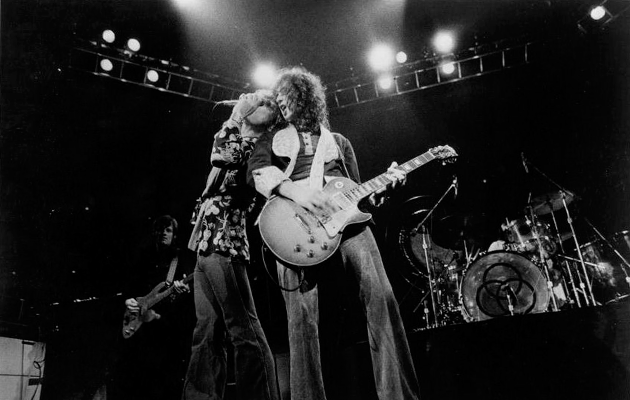Led Zeppelin’s sixth album, was also, to varying extents, Led Zeppelin’s third, fourth and fifth albums – the fifteen-track running order, consuming 82 minutes and four side of vinyl, consisted of eight new songs, amalgamated with seven out-takes from III, IV and Houses Of The Holy. When Zeppelin began work on Physical Graffiti, in what proved to be abortive early sessions in late 1973, they were – with apologies possibly due to The Rolling Stones – arguably the biggest, certainly the most infamous, rock’n’roll band in the world.
All that remained was the creation of a definitive magnum opus – their own gatefolded masterpiece to file alongside Exile On Main St, the White Album and Quadrophenia. Physical Graffiti could – and in less adroit hands, assuredly would – have been preposterous, the moment at which Zeppelin’s imperial phase collapsed in a goutish wheeze of decadent hubris. Instead, it’s magnificent: the Rome that wouldn’t fall.
This reissue appears in a panoply of formats. There’s a straightforward double CD, a triple CD including a bunch of hitherto unreleased stuff, vinyl and digital equivalents of both those options, and a “super deluxe” box set including all of the above along with alternate cover art, a book of previously unseen photographs, and a print of the original cover, the first 30,000 of which will be individually numbered. It has also been remastered by Jimmy Page, indefatigable curator of Zeppelin’s legacy, who may be unique in being able perceive significant difference between this and the original, or in thinking there was much wrong with the way Physical Graffiti sounded the first time.
The enticement of this reissue is a batch of previously unheard early versions of seven of the fifteen tracks which comprise the epic sprawl of Physical Graffiti. These latest exhumations from Jimmy Page’s attic contain few forehead-slapping revelations. “Brandy & Coke”, an early take on “Trampled Under Foot”, comes much cleaner on the finished song’s debt to Stevie Wonder’s “Superstition”. “Driving Through Kashmir”, part of the journey to one of Zeppelin’s loftiest peaks, suggests that there was a point at which an argument was made for turning up the trumpets slightly.
A shorter, softer instrumental version of “Sick Again” permits appreciation of how pretty Zeppelin were capable of being when dropping to the swaggering priapic metal colossi schtick for a couple of minutes, and also spares the listener Robert Plant’s exposition of the sexual politics of Hollywood’s groupie scene of the early 70s (“The fun of comin’/The pain in leavin’,” etc – arguably, you had to be there.) Of the new versions of “In My Time Of Dying”, “Houses Of The Holy”, “Everybody Makes It Through The Night” and “Boogie With Stu”, it is difficult to sum up much reaction beyond the thought that they’re not as good as the familiar, finished versions – of some interest to completists and/or musicologists, perhaps, but not worth the price of re-purchase.
This is, of course, the nature of early takes – although, at the risk of prompting another deluge of expensive reissues, it might be more interesting to hear some really early takes. Where, for example, does one even begin assembling something as monumental as “Kashmir”? What were the first notes plucked or prodded that eventually became “In The Light”? From where did Zeppelin find the nerve to run “In My Time Of Dying” out to eleven – still utterly compelling – minutes?
It’s this ironclad – metalclad, if you will – confidence that makes Physical Graffiti such a gripping listen. So very many things could have gone wrong; none of them do. When Zeppelin are silly and puerile, they manage to sound guileless and charming – just as Plant is possibly not really singing about a car when he begs to be permitted to pump gas and dig under the hood on “Trampled Under Foot”, it’s plausible that “Custard Pie” is not actually about dessert. When Zeppelin are pompous and preposterous, they’re also perfectly poised – in the years ahead, many would seek to conquer the heights of “Kashmir”, and most would pratfall spectacularly. And the rare excursions into modesty are all the more affecting amid the sturm and drang elsewhere – Page’s acoustic instrumental noodle “Bron-Yr-Aur”, named for the Welsh cottage where Zeppelin composed much of III, and originally recorded for that album, is a deceptively nonchalant expression of his mastery of his instrument.
In retrospect, Physical Graffiti stands as Peak Zeppelin. Its sheer size and scope, and the epoch-spanning, piecemeal nature of its assembly, give it the feeling of an accidental best-of. And while Zeppelin’s two subsequent proper studio albums, Presence and In Through The Out Door, had their moments, they also – substantially as a function of having to follow Physical Graffiti – felt somewhat like exercises in decline management. The album endures as a bequest to the bogglement of the ages.



